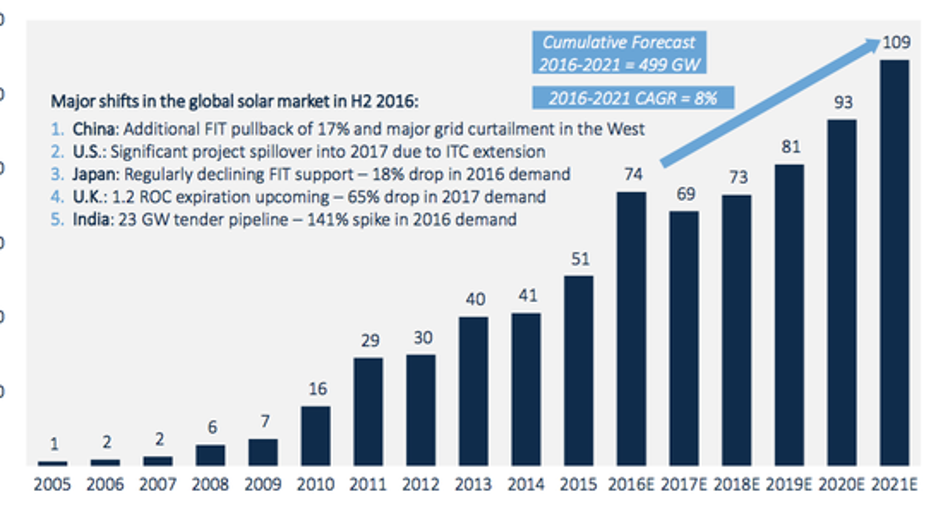Solar Stock Update: India and China Are the Key in 2017

The solar industry in 2016 has been defined by big, sweeping changes. China installed 20 GW of solar in the first half of the year, more than any country had ever installed, but fell flat in the second half, sending solar panel prices tumbling by 25% in a single quarter. The U.S. investment tax credit led to a boom in solar and an estimated 14.1 GW in total installations this year, but the extension also led to utilities having little appetite for new solar projects in 2017, which has led to very few new projects slated for next year.
As we look forward to 2017 and beyond, the two big factors I'll be watching closely are China and India. China has shown a tremendous appetite for solar energy and will want to keep its factories churning out product, and India could be the new growth market for the industry next year.
Image source: Getty Images.
India's big bet in renewable energy
A recent report from India's Ministry of New and Renewable Energy says the country installed 5.8 GW of solar energy in the last two and a half years, but that's just the start. In the year starting in April 2016 the country wants 12 GW of new solar, with 15 GW and 16 GW following the next two years.
This isn't a small amount of solar for any country. 15 GW will be 22% of total global demand in 2017, according to a recent report by GTM Research.
Image source: GTM Research Global Solar Demand Monitor: Q4 2016.
First Solar, Inc. (NASDAQ: FSLR) and SunPower Corporation (NASDAQ: SPWR) both aspire to grow their presence in India. First Solar's thin-film panels may fit desert regions well, and it's built projects in the country in the past. SunPower has mentioned that it hopes moving to a solutions model, which may allow local developers to be partners, will help gain market share in the booming market. Canadian Solar (NASDAQ: CSIQ) is alsotrying to gain a presence in India, recently buying 49% of a 15 MW project there. It's a small stake, but could lead to more growth in the country.
What's clear is that the opportunity is tremendous. Even at an industry-low cost structure of $1 per watt, the Indian market will be worth over $15 billion next year alone. And that's enough to alter the entire solar industry.
China's huge solar energy ambitions
According to solar research firm Mercom Capital Group, China is expected to install 31 GW of solar in 2016, but only 9 GW in the second half of the year. But 2017 will see about 17.5 GW installed as demand stabilizes and a new feed-in tariff rate sets in.
Next year may be a slowdown for China's solar industry overall, but it'll still be the biggest solar market in the world by a wide margin, easily topping projections for around 13 GW in the U.S. But there's a lot of upside potential if installations surge to anywhere near the level we saw in early 2016.
The countries that need a renewable future
One thing that drives renewable energy, and solar in particular, in India and China is that they have a constant need for more energy. As utilities and political leaders look at the energy landscape they see solar and wind becoming competitive economically without the pollution and imports that would come with building more coal plants.
10 stocks we like better than First Solar When investing geniuses David and Tom Gardner have a stock tip, it can pay to listen. After all, the newsletter they have run for over a decade, Motley Fool Stock Advisor, has tripled the market.*
David and Tom just revealed what they believe are the 10 best stocks for investors to buy right now... and First Solar wasn't one of them! That's right -- they think these 10 stocks are even better buys.
Click here to learn about these picks!
*Stock Advisor returns as of Nov. 7, 2016
Travis Hoium owns shares of First Solar and SunPower. The Motley Fool has no position in any of the stocks mentioned. Try any of our Foolish newsletter services free for 30 days. We Fools may not all hold the same opinions, but we all believe that considering a diverse range of insights makes us better investors. The Motley Fool has a disclosure policy.